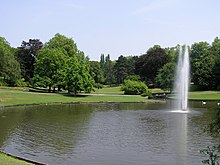Parc Barbieux
The Parc Barbieux is a 34-hectare park in the northern French city of Roubaix , which - lying in a depression between two hills over a length of 1.5 kilometers - has several small lakes and is home to various plant and animal species.
Location and layout
The city park is the "green lung" in the southwest of the old industrial city, on the border with the municipality of Croix, and attracts many residents and tourists for walks, pedal boating and similar leisure activities or recreation.
It consists of two large parts that are separated from each other by the Avenue du Peuple Bèlge . It connects the higher avenues, avenue Jean Jaurès and avenue Le Nôtre, which run parallel to the park .
In the elongated lake complex in the southern part there are two islands called Île heureuse (dt. Happy island ) and Île de la folie (dt. Island of foolishness ). In addition to the diverse flora and fauna, there are various creative means such as several small cascades , statues and monuments, a grotto.
The park is looked after by around 13 permanent employees and additional part-time employees.
Flora and fauna
The park has around 135 different tree species (including the manna ash , Turkish hazel and 50 different coniferous trees ) and 200 types of shrub . In addition, 1,000 m² are used as flower beds.
In addition to the extensive flora, there is a diverse fauna in the park: Canadian wild geese , mallards , musk ducks , mute swans , gray herons , and much more
On September 4, 1991 the association “Amis du Parc Barbieux” (dt. Friends of the Parc Barbieux ) was founded, which is dedicated to the preservation and care of the flora and fauna of the park and has its seat in the restaurant in the park “ Le Beau Jardin ”.
origin of the name
The name "Barbieux", which was given to the park and a nearby hospice, comes from old landowners in Roubaix called Barbieurs . From this family Guilbert des Barbieurs emerged. In the 15th century he was governor of Roubaix and had a fiefdom of a few hectares. This property, on which there was an estate, was given the name "de Barbieux", which has survived to this day.
history
From the sewer construction project to the unfinished construction site
The origin of the park is in the 17th century in a design by the master builder Vauban for the construction of a canal that stretched across northern France and was supposed to connect Roubaix with Croix.
The canal construction project was resumed in 1821 and construction work started. The first draft of the Canal de Roubaix was to lead past Roubaix to the south. However, there was a hill between Croix and Roubaix. The former property of the above-mentioned Guilbert des Barbieux was on this hill, which was also called the montagne de Barbieux . At the height of today's rue Dammartin, the hill should be tunneled under. At that time people spoke of the “tunnel of Barbieux”. However, the swampy terrain prevented the tunnel from being built: the shafts collapsed and caused numerous accidents. The canal construction had to be rerouted. The northern, already completed section of the route became Boulevard Gambette and the shafts ("les puits de Barbieux" called) in the extension of the axis to a promenade (today's Boulevard du Générale de Gaulle ), which led into the depression of today's park.
The creation of the park
In 1859 the bookkeeper and poet Henri Léon Lizot came up with the idea of turning the “puits de Barbieux” into a park. In 1860 a draft for the construction of a promenade in the area of today's park in the town hall was submitted. In 1863 the mayor of Roubaix accepted the design of the famous landscape gardener Barillet-Deschamps. However, the plans were only executed in two major construction phases in the years 1878–88 and 1903–06 in the form of an English garden with several lakes and small cascades. The Parisian architect Georges Aumont adopted Barillet-Deschamps' designs and added them to a minimal extent. With a donation of 32,000 francs from Pierre Destombes to the city on June 25, 1907, the building project was completed. Among other things, a milk café was built that no longer exists today. Another attraction, the music pavilion from 1881, is no longer preserved today.
The cultural heart of Roubaix in the 20th century
In 1921, the part located in the municipality of Croix was handed over to Roubaix and the western boulevard ( Avenue Jean Jaurès ) was built. At the beginning of the 20th century, the Parc Barbieux, then also known as "Le Beau Jardin", was considered one of the most beautiful city parks in France. It is the largest city park north of Paris.
From May to November 1911 the "Exposition Internationale du Nord de la France" took place in the Parc Barbieux and in 1939 the "Exposition du Progrès Social" (German exhibition of social progress ).
On January 26, 1994 he was officially included in the list of sights of the North , as the "Journal Officiel de la République Française" of February 22, 1994 was to be inferred. In 2002 Roubaix won the “Grand Prix national de l'arbre”.
swell
- Philippe Waret and Jean-Pierre Popelier: Roubaix de A à Z . Editions Alain Sutton, Saint-Cyr-sur-Loire, 2006. ISBN 2-84910-459-0
Web links
- Official website of the city of Roubaix for Parc Barbieux (French)
Coordinates: 50 ° 40 '33.39 " N , 3 ° 9' 41.39" O

